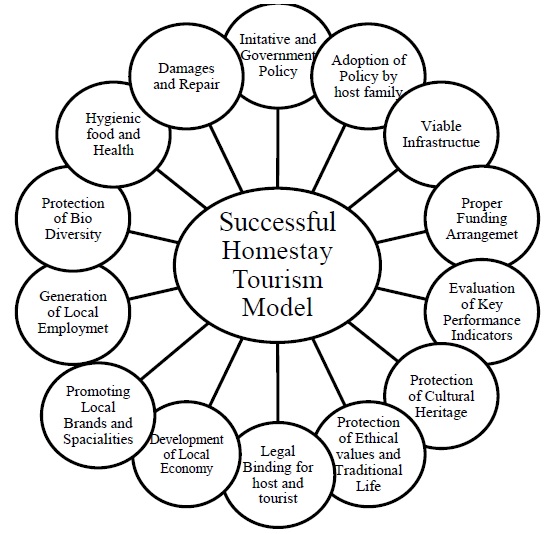Homestay Tourism and Sustainable Development in the Indian Himalayan Region: Prospects & Challenges
DOI:
https://doi.org/10.54741/mjar.3.5.3Keywords:
guest, homestay, host, indian himalayan region, tourismAbstract
In developing countries like India, homestay tourism is a relatively a new concept that has been introduced in the field of tourism and travel. It has number of benefits at social, economic and environmental level and simultaneously, it has certain limitations also. Purpose of this research paper is to evaluate the social, economic and environmental issues of homestay in Indian Himalayan Regions so that various tourism policies can be framed. Another purpose is to decide whether homestay is good & safe for an individual as a host and as a guest. Future potentials of home stay tourism has also been highlighted in the present paper and it also carry number of challenges faced by homestay tourism. Some proposed measures to improve homestay tourism have been given. It has been linked with sustainable development also. As per the expectations of the author, the present paper is going to give a lot of ideas & benefits to not only those people who are connected with tourism and travel but it will also give an idea to the govt., environmentalist, young generation, gen-z (specially residing in Himalayan region), spiritual and religious organisations, people interested in knowing the traditions and culture of other regions and to both guest and host community. The focus of the paper is empowering local and rural communities towards homestay tourism and preserving heritage culture of the people residing in Indian Himalayan Regions. Various marketing strategies to promote home stays has also been highlighted in this paper.
Downloads
References
Singh, S. (2008). Destination development dilemma: case of manali in himachalhimalaya. Tourism Management, 29, 1152-1156. doi: 10.1016/j.tourman.2008.02.018.
Sood, J., Lynch, P., & Anastasiadou, C. (2017). Community non-participation in homestay in Kullu, Himachal Pradesh, India. Tourism Management, 60, 332-347.
Thompson-Fawcett, M. (2019). Rural change and tourism in remote regions: Developments and indigenous endeavour in Westland, Te Tai o Pountini, Aotearoa, New Zealand. New Zealand Geographer, 75, 194-203. doi: 10.1111/nzg.12236.
Urry, J. (1990). The consumption of tourism. Sociology, 24(1), 23-35.
Walter, P., Regmi, K. D., & Khanal, P. R. (2018). Host learning in community-based ecotourism in Nepal: The case of Sirubari and Ghalegaun homestays. Tourism Management Perspectives, 26, 49-58.
Wang, Y. (2007). Customized authenticity begins at home. Annals of Tourism Research, 784-804. doi:10.1016/j.annals.2007.03.008.
Zhao, L., & Xia, X. (2019). Tourism and poverty reduction: Empirical evidence from China. Tourism Economies, 26(2), 233-256. doi: 0.1177/1354816619863266.
Gao, S., Huang, S., & Huang, Y. (2009). Rural tourism development in china. International Journal of Tourism Research, 11, 439-450. doi: 10.1002/jtr.712.
Garrod, B., Wornell, R., & Youell, R. (2006). Re-conceptualising rural resources as countryside capital: the case of rural tourism. Journal for Rural Studies, 22, 117-128. doi: 10.1016/j.jrurstud.2005.08.00.1.
Gautam, V. (2012). An empirical investigation of consumers' prefrences about tourism services in indian context with special reference to state of himachalpradesh. Tourism Management, 33, 1591-1592. doi: 10.1016/j.tourman.2011.12.014 .
Government of Himachal Pradesh. (2021, 11 7). Himachal Tourism. Retrieved 11 7, 2021, from himachaltourism.gov.in: https://himachaltourism.gov.in/ Government of India. (2011). Top 10 least urban states of India. Retrieved 16 11, 2021, from www.census2011.co.in: https://www.census2011.co.in/facts/topstaterural.html.
Jamal, S. A., Othman, N., & Nik Muhammed, N. (2011). The moderating influence of psychographics in homestay tourism in Malaysia. Journal of Travel and Tourism Marketing, 28, 48-61. doi: 10.1080/10548408.2011.535443.
Kontogeogopoulos, N., Churyen, A., & Deangsaeng, V. (2015). Homestay tourism and commercialization of rural home in Thailand. Asia Pacific Journal of Tourism Research, 20(1), 29-50. doi: 10.1080/10941665.2013.852119.
Kumar, R., Gill, S. S., & Kunasekharan, P. W. (2012). Tourism as a poverty eradication tool for rural areas in Selangor, Malaysia. Global Journal of Human Social Science, 12(7).
Li, Y., Zhang, H., Zhang, D., & Abrahams, R. (2019). Mediating urban transition through rural tourism. Annals of Tourism Research, 75, 152-164. doi: 10.1016/j.annals.2019.01.001.
Liu, J., Nijkamp, P., & Lin, D. (2017). Urban-rural imbalance and tourism-led growth in china. Annals of tourism research, 64, 24-36. doi: 10.1016/j.annals.2017.02.005.
Lynch, P. A. (2005a). Sociological impression in a hospitality context. Annals of Tourism Research, 32(3), 527-548.
Mura, P. (2015). Perception of authenticity in a Malaysian homestay- a narrative analysis. Tourism Management, 51, 225-233.
Nepal, S. (2005). Tourism and remote mountain settlements: Spatial and temporal development of tourist infrastructure in the Mt. Everest region, Nepal. Tourism Geographies, 7(2), 205-227. doi: 10.1080/14616680500072471.
Nivolli, M. (2005). Niche tourism: an introduction. in M. Nivolli, & M. Robinson, Niche Tourism: Contemporary Issues, Trends and Cases, pp. 1-14. Oxford: Elsevier.
Regmi, K. D., & Walter, P. G. (2016). Conceptualising host learning in community-based ecotourism homestays. Journal of Ecotourism, 15(1), 51-63. doi: 10.1080/14724049.2015.1118108.
Salvatore, R., Chiodo, E., &Fantini, A. (2018). Tourism transition in peripheral rural areas: theories, issues and strategies. Annals of Tourism Research, 68, 41-51. doi: 10.1016/j.annals.2017.11.003.

Downloads
Published
How to Cite
Issue
Section
License
Copyright (c) 2023 Dr. Prithvi Raj Sanyal, Sunita Kuamri, Dr. Gulnaz Siddiqui

This work is licensed under a Creative Commons Attribution 4.0 International License.
Research Articles in 'Management Journal for Advanced Research' are Open Access articles published under the Creative Commons CC BY License Creative Commons Attribution 4.0 International License http://creativecommons.org/licenses/by/4.0/. This license allows you to share – copy and redistribute the material in any medium or format. Adapt – remix, transform, and build upon the material for any purpose, even commercially.









